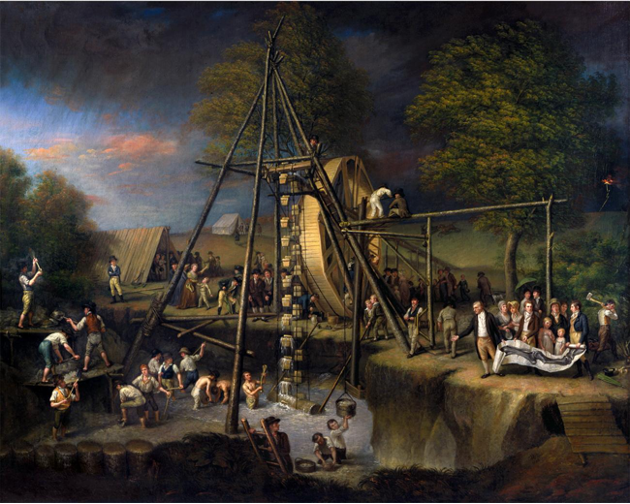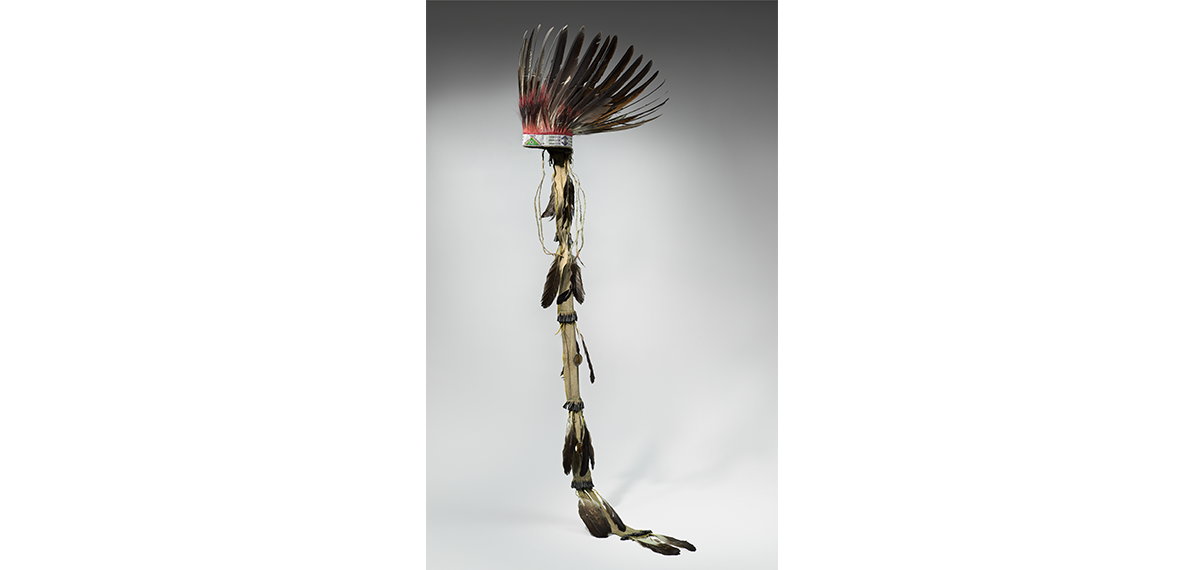How do incongruent temporalities jockey for primacy in individual works of art? Does belatedness have a materiality, and if so, how is it construed visually? This session comprises individual case studies which analyze a variety of media, from painting and architecture to design and regalia. The talks analyze how, constructed in the fabric of objects and spaces, belatedness operates as a revealing and malleable myth in the context of settler-Native American and other transnational relationships, as well as human-nature dialogues.
Organised by Professor Emily C. Burns (Director of the Charles M. Russell Center for the Study of Art of the American West at the University of Oklahoma) and Professor David Peters Corbett (Professor of American Art and Director of the Centre for American Art, The Courtauld) as part of the ‘Belatedness and North American Art‘ series.
Constructing a Fictional Past: Penn’s Treaty Across Media
Laura Turner Igoe, Chief Curator, James A. Michener Art Museum
In 1772, Benjamin West’s painting Penn’s Treaty with the Indians (1771-72) belatedly established a visual record for an event with a murky history and limited documentation that occurred over a century prior. West’s composition depicting a treaty of peace between the Pennsylvania Province’s founder William Penn and Tamanend, Chief of the Lenni-Lenape Turtle Clan went viral in a pre-internet age, appearing on textiles, porcelain, and other printed material in the late 18th and 19th centuries. The carefully-crafted myth of Penn’s Treaty also circulated throughout the Atlantic World in the form of relics made from the wood of the Treaty Elm, under which it was believed the treaty occurred. Despite the deceitful and violent displacement of the Lenape people by Anglo-Americans during the infamous Walking Purchase and throughout the 18th century, the legend of Penn’s Treaty and its peaceful agreement persisted, and even flourished, thanks to the tangibility and obtainability of the Treaty Elm relics and consumable goods branded with West’s image. This paper explores how these objects, while inarguably invested in preserving and commemorating the memory of William Penn, solidifying social networks, and reinforcing ideological and political values of the young United States and Quakerism, attempted to rewrite the fraught history of Native and Anglo-American conflict with a myth of peaceful co-existence.
Laura Turner Igoe, Ph.D. is Chief Curator at the James A. Michener Art Museum in Doylestown, Pennsylvania. She specializes in art and material culture of the long nineteenth century and has held curatorial and research positions at the Philadelphia Museum of Art, Princeton University Art Museum, Harvard Art Museums, and the Barnes Foundation. Laura is the coeditor of A Greene Country Towne: Philadelphia’s Ecology in the Cultural Imagination and she has contributed essays to the journals American Art, Panorama, Common-place, and the exhibition catalogue Nature’s Nation: American Art and Environment. At the Michener, she curated Impressionism to Modernism: The Lenfest Collection of American Art (2019), Rising Tides: Contemporary Art and the Ecology of Water (2020) and co-curated Through the Lens: Modern Photography in the Delaware Valley (2021) and Daring Design: The Impact of Three Women on Wharton-Esherick’s Craft (2021-2022).

Belatedness and Materiality: Extracting Peale’s Mastodon from the Pit
Sarah J. Moore, Professor of Art History, University of Arizona
This paper considers Peale’s Exhumation of the Mastodon, 1806-08, as a case study for an ecomaterialist approach to the history of art in the United States and its intersection with the problematics of belatedness. The painting visualizes Peale’s team of workers in the process of excavating bones—irrefutable evidence—of an animal yet unknown and unnamed while the artist, standing at the edge of the watery pit, unravels a scroll on which he imagined the coherence of the not-quite-known-yet late comer which was to destabilize Enlightenment assumptions of the static order and immutability of nature. The enthusiasm that greeted Peale’s unveiling of the reconstructed skeleton in late 1801, just over six months after the excavation, failed to be dampened by the fact that small sections of the skeleton remained unfound—belated, we might say—and had to be fabricated out of wood. In the painting, everything is belated matter—the “real” bones, the images of bones, the landscape, the canvas, the dirt—awaiting Peale’s ability to transform the incognitum into a coherent universe much as he transforms the chaos of nature into the rationalized space of the grid in his museum.
Sarah J. Moore, Professor of American Art History, University of Arizona, is the 2021-2022 Terra Foundation for American Art Visiting Professor, Doshisha University, Kyoto, Japan. The shifting terrain of identities and geographies animate her work as a scholar of art in the United States and include the global interdisciplinary arena of world’s fair studies and ecocriticism in visual culture. Recent publications include: “The Panama Canal as a Hybrid Zone,” Ecocriticism and the Anthropocene in Nineteenth-Century Art and Visual Culture (Routledge, 2020); and “The Great American Desert is No More,” Trans-Mississippi and International Exposition of 1898-99 (University of Nebraska Press, 2018).

War Bonnets In and Out of Time
Layla Bermeo, Kristin and Roger Servison Curator of Paintings, Art of the Americas, Museum of Fine Arts, Boston
The dramatic feathered headdress donned by the lone horseman in Cyrus Dallin’s Appeal to the Great Spirit (1909) has long represented Indigenous “authenticity” to international viewers; the recognizability of the figure as Native depends on it, even though Indigenous peoples in Massachusetts, where Dallin modelled the sculpture, never wore such regalia. This paper explores the image of the war bonnet as an enduring marker of Indigeneity for non-Native audiences, solidified in the work of white artists and adapted by Native peoples themselves around the turn of the twentieth century. Why did representations of feathered headdresses, typically inspired by traditional regalia from Cheyenne, Lakota, and other Plains communities, become simultaneously bound to myths of extinction and highly visible in contemporary art? How did the making and meanings of such headdresses shift among different Native peoples? This paper also presents new research on a war bonnet in the MFA Boston’s collection suspected to be a fake or an amalgamation created for the tourist trade. Although the headdress came to the Museum in 1991, it was first sold at the Fred Harvey Indian Building in Albuquerque, New Mexico in 1917. The histories of collecting war bonnets—the ways in which these objects entered the hands of white collectors and museums as relics of the past as they took on new significance among many Indigenous peoples—is one of several examples of their split relationship to time.
Layla Bermeo is the Kristin and Roger Servison Curator of Paintings, Art of the Americas, at the Museum of Fine Arts, Boston. She has held curatorial positions at the Philadelphia Museum of Art and the African American Museum in Philadelphia. She has a BA from Northwestern University, an MA from Williams College, and she is a Ph.D. candidate at Harvard University. At the MFA, Layla co-organized “Collecting Stories: Native American Art,” curated “Frida Kahlo and Arte Popular,” and developed the “Curatorial Study Hall” youth mentorship program. In 2019, WBUR, an NPR news station, named Layla as one of the 25 millennials of color impacting Boston arts.

Olana’s Object Worlds
Mary Roberts, Professor of Art History and Nineteenth-Century Studies, University of Sydney
Frederic Church spent three decades landscaping and building Olana, his large property and Persian-inspired home overlooking a spectacular bend in the Hudson River. This paper poses the question: what time is it in this orientalist interior? Church integrated his paintings and myriad objects within his dwelling and created key sightlines in the building that orchestrated both this interior and his landscaping outside into an immersive aesthetic experience, the suspended time of an aesthetic present tense. This was his cosmopolitan gesamtkunstwerk. Yet Persian ceramics integrated within this interior, dated according to the Hijri calendar, take us to a world governed by a different measure of time, to contemporary art making and state-making in Tehran. This paper foregrounds the complex optics of Church’s orientalism that has not been fully apparent to us because of the enduring legacy of national frames of reference for writing the history of North American art. These national frames have severed our understanding of the language of Church’s cosmopolitan aesthetic and the anachrony of its errant objects.
Mary Roberts is Professor of Art History, University of Sydney. Working at the intersection of modernism and orientalism, she pursues global networks that inform nineteenth-century European and Islamic art. Her books include Istanbul Exchanges (University of California Press, 2015), awarded AAANZ’s Book Prize and translated into Turkish, and Intimate Outsiders (Duke, 2007). She co-edited Ottoman Istanbul and British Orientalism (2011), Edges of Empire (2005), Orientalism’s Interlocutors (2002), and Refracting Vision (2000). She has held fellowships at the Getty, CASVA, YCBA, and the Clark. Her next book is titled Four Thresholds: Orientalist Interiors, Islamic Art, the Aesthetics of Global Modernities.

Seacoasts and the belatedness of painting in the work of Martin Johnson Heade
Kimia Shahi, Assistant Professor of Art History, University of Southern California, and Kernan Brothers Environmental Fellow, Harvard University Center for the Environment
During the nineteenth century, scientific fields like geology, meteorology, natural history, and oceanography measured time across ever-widening array of scales, cycles, and speeds, challenging old ideas about the earth’s past and drawing new attention to the dynamic interconnections among species and phenomena. Foregrounding the co-constitutive relationships between period science and aesthetics, this paper considers how such expanded conceptions of time in nature offered new possibilities for picturing time in paintings. I focus on the work of Martin Johnson Heade (1819-1904), a naturalist and artist with a career-spanning interest in seacoasts; terrains where atmospheric, terrestrial, and oceanic forces converge in constant motion, rendering different kinds of time material and visible. Oscillating between stillness and instantaneity, Heade’s depictions of these terrains materialize multiple – and sometimes competing – temporal scales, speeds, and rhythms, flouting period conventions of orienting a beholder in space and time. In this way, Heade’s pictures strive to overcome their own belatedness by functioning as devices that record and register the fluctuating landscapes around them, beyond the limits of observation alone.
Kimia Shahi is Assistant Professor in the Department of Art History at the University of Southern California. Her work centers on multidisciplinary intersections of art, visuality, and knowledge production in the long 19th and 20th centuries, focusing on geography, empire, environment, and ocean history. Her current book project examines saltwater coastlines – and the ways they were pictured – as grounds for enlarging, synthesizing, and contesting ways of seeing and knowing the natural world in the greater 19th-century United States. Kimia has contributed to publications such as American Art, Art Papers, and Nature’s Nation: American Art and Environment. She is currently the 2021-23 Kernan Environmental Fellow at the Harvard University Center for the Environment.

